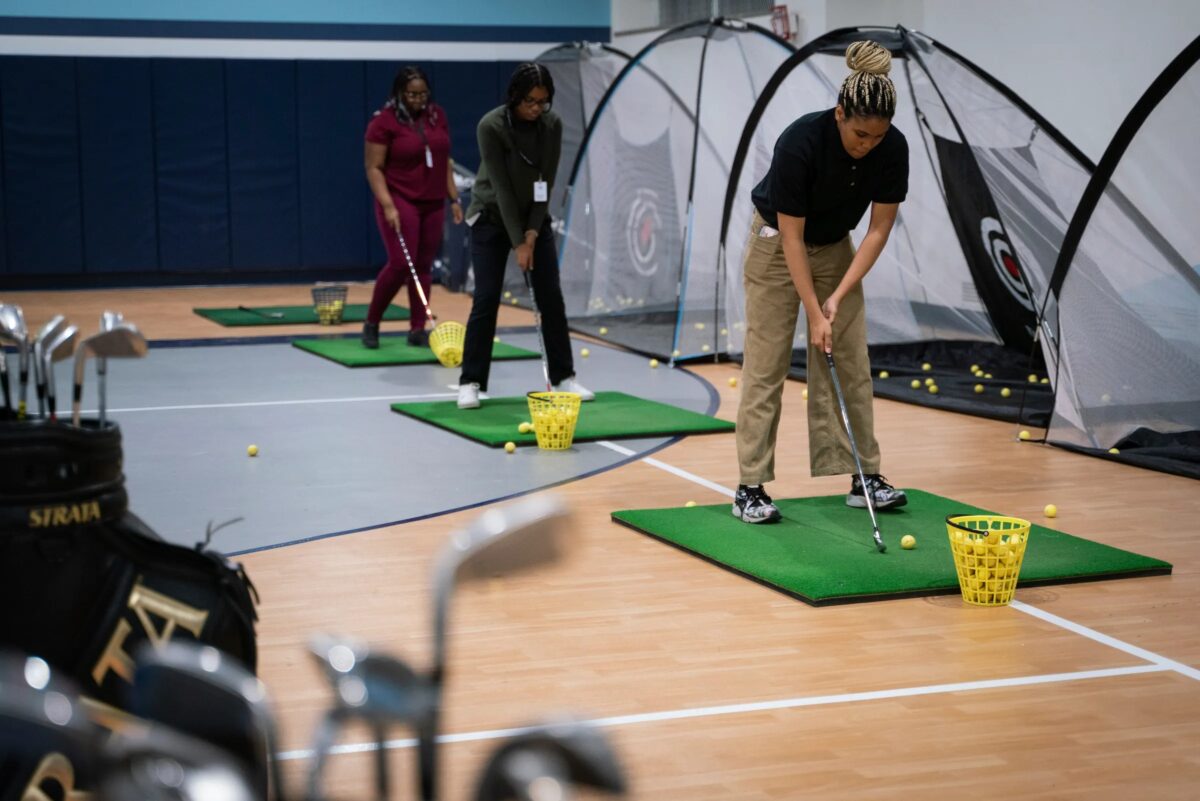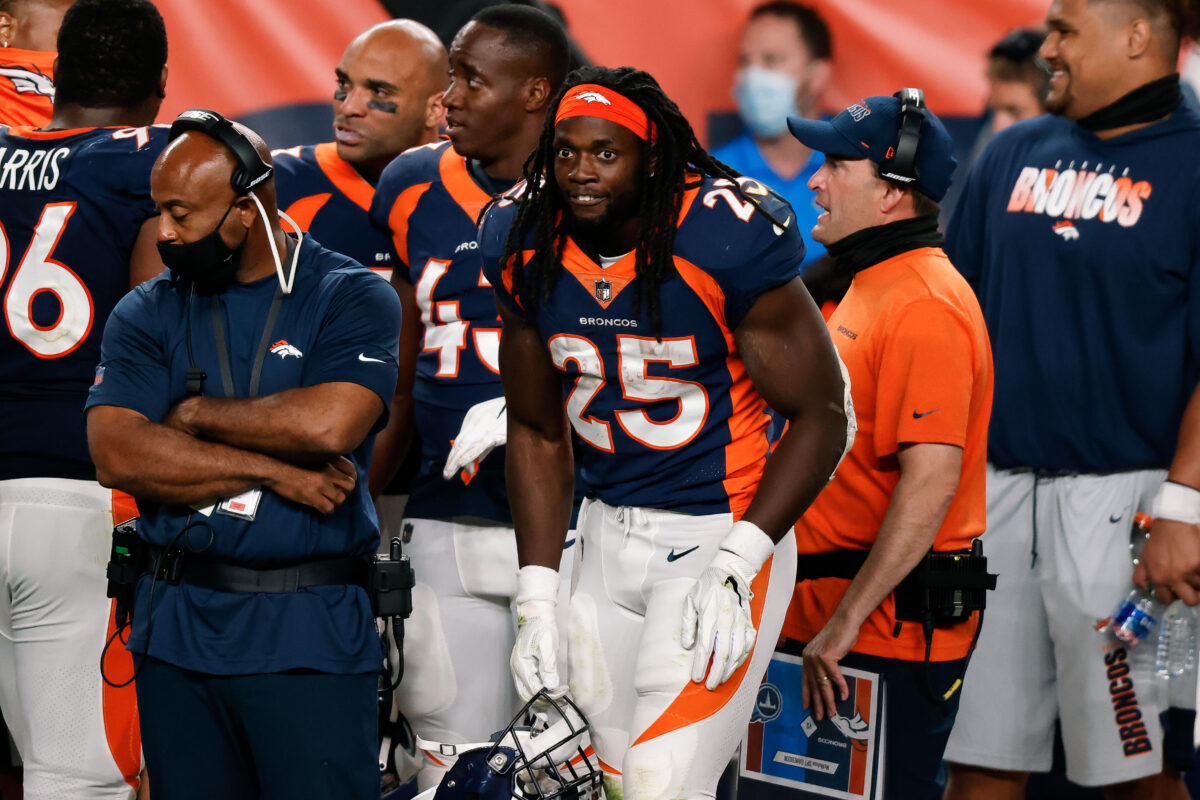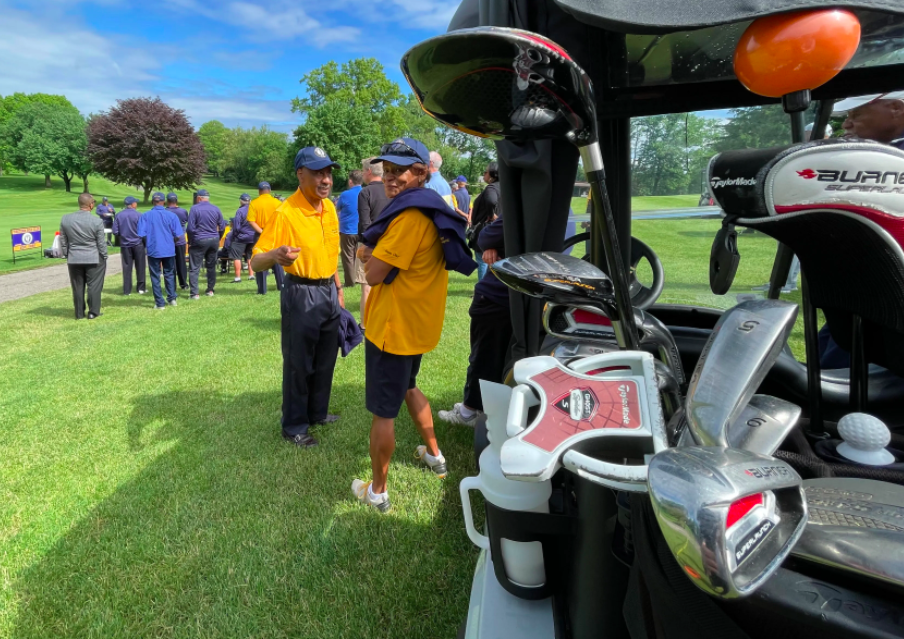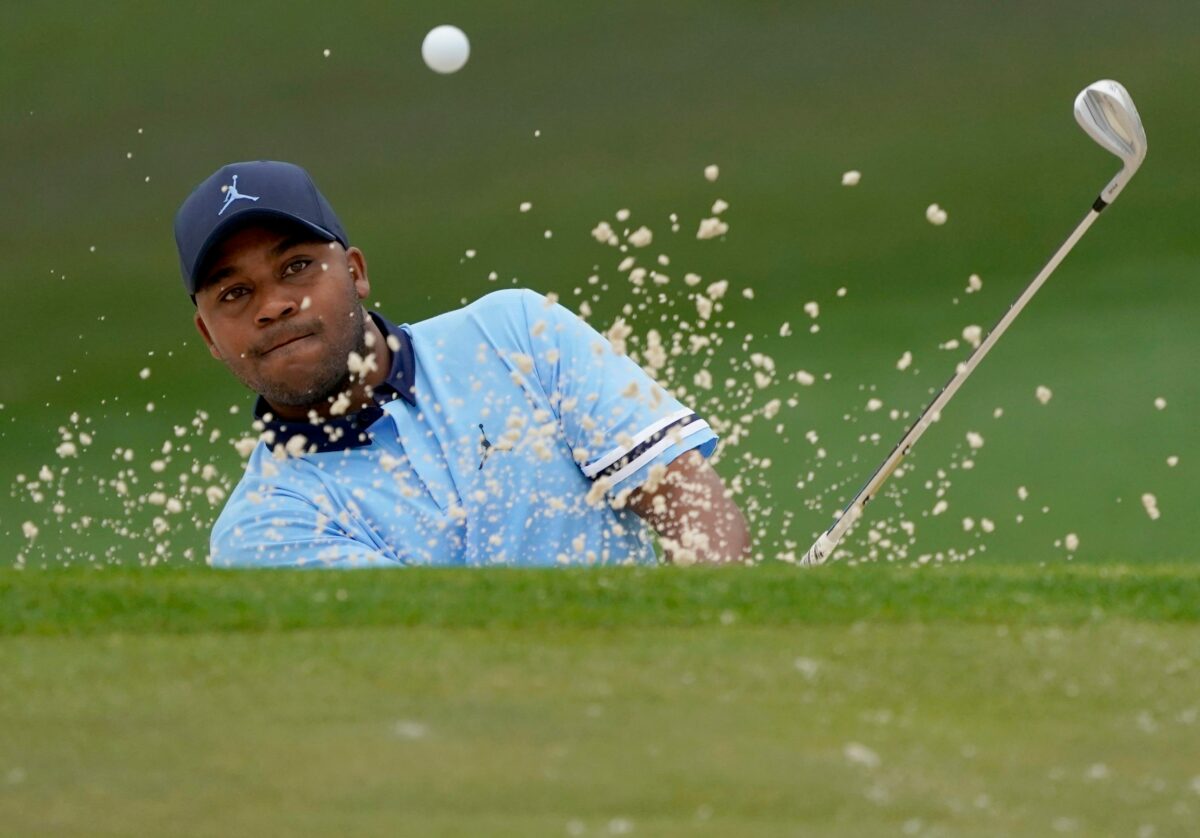DETROIT — During recent evenings at an iconic location in northwest Detroit, many of the elements one might associate with a festive Super Bowl party filled the room: lively conversations, discussions of strategies, brief periods of silence during critical moments. And real food, like baked chicken slathered in barbecue sauce, accompanied by hot side dishes like potatoes and string beans — all in heaping helpings.
But this was no Super Bowl party. And the stakes, for many, are much higher and more personal, not dictated by a date on a calendar or a scoreboard clock.
The activities that were taking place inside the Liberal Arts building on the Marygrove Conservancy campus will continue for several more weeks this year. The scene was consistent with the game plan that has been carried out since 2001 when the Midnight Golf Program began providing life-changing programming to metro Detroit youths. And unlike football rosters that change each year, being a member of the Midnight Golf family can be a lifelong bond once the connection is made.
“You stay with us, we stay with you,” explained Detroit native Renee’ Fluker, founder and president of the nonprofit Midnight Golf Program. For starters, each year, the program conducts a 30-week program focused on mentoring and positive personal transformation for 250 high school seniors, who also learn how to golf in the process.
Those taking part in the program have an opportunity to go on the Road Trip for Success College Tour, scheduled for March 26 through April 1 in Atlanta and Charlotte, North Carolina, featuring eight college visits, exposure to sites of cultural significance, and more golf. When the six busloads of students roll back into Detroit following the college tour, there will be more after-school programming combining the development of life skills, mentoring and golf at Marygrove.
And on May 10, there will be a Pinning Ceremony at Fellowship Chapel church, where the graduating high school seniors will be presented with scholarships and receive special awards and further encouragement from community members and leaders. The students also will have an opportunity to make a pledge to officially join the Midnight Golf family while being pinned, and those students that make that pledge will give their word that they will give back to the program and their community to the best of their ability, in the same manner Midnight Golf has provided for them.
“I feel that I’m out here doing God’s work,” said Fluker, who reported that the 2022 Midnight Golf graduating senior class received more than $250,000 in scholarships before going off to colleges and universities across the country. “Our young people, they want to do something. They want to be pushed.”
The pride of Wingert Elementary School, Webber Junior High and Cooley High School (Class of 1972), Fluker speaks in dulcet tones. Yet, despite the softness of her voice, Fluker says she has never had a problem being heard by Midnight Golf participants, who, as she explained, even love to hear “Ms. Renee’” fuss because it reflects how much she cares about the program and each student.
There also have been moments during Fluker’s life when her passion and intensity were felt without her having to say a word. Like in 2000 when Fluker accompanied her son, Jason Malone, to Florida for the Bill Dickey Invitational Junior Golf Championship, an annual showcase for young golfers of color. During the two-day tournament, Fluker caught the eye of Earnie Ellison Jr., the former director of business and community relations for the Professional Golfers’ Association of America.
“Earnie Ellison came up to me and said he admired how I walked every hole with my son and supported him. I told him I do that all the time. And then he said I should consider starting a youth program in Detroit because the PGA was coming to Detroit for the Ryder Cup (played in 2004 at Oakland Hills Country Club) and they wanted to support a program that reflected their commitment to making an impact in the communities where their tournaments are played,” Fluker recalled.
At the time of Fluker’s encounter with Ellison, she was nearing the end of her 35-year career with the Michigan Department of Health and Human Services, and as she puts it, starting a youth development program was not exactly on her “short list” of things to do. Plus, at the time Fluker met Ellison, she had not yet learned to play golf herself. However, by connecting with the game through her son, who played on the University of Detroit Jesuit High School golf team before earning a scholarship to Loyola University Chicago, Fluker had witnessed up close how golf could enrich a young person’s life, even beyond a golf scholarship.
Fluker said she soon discovered that golf was also a “good networking tool” that gave kids an opportunity to enjoy the outdoors and think about their future in the process. So, later in 2000, with a push from her son and godmother — the late Julia Baldwin, a 2019 inductee into the Michigan Women’s Golf Association Hall of Fame — Fluker, a former social worker, answered Ellison’s call to action and began making plans. She got together with a circle of other committed, community-focused folks to create a nonprofit linked to golf and so much more that would “help the kids in the city of Detroit.”

The “help” that Fluker hoped to provide through Midnight Golf has now touched more than 4,000 lives, including Dr. Shakyra Rivers, a member of the first Midnight Golf graduating class, who recently made Fluker’s weekend when she reached out from Washington, D.C. and asked if “Ms. Renee,” who attended Rivers’ graduations from Howard University and Wayne State University, in addition to her wedding, could help plan Rivers’ 40th birthday.
Even closer to Fluker, in a geographic sense, is Demetrius Scott, director of corporate citizenship for Detroit-based Ally Financial, where he spearheads Ally’s financial education efforts in the community. On Tuesday evening, Scott and his “Wallet Wise” presentation on budgeting were the only things standing in the way of dinner for the Midnight Golf students that come to Marygrove on Tuesdays and Thursdays (another group of Midnight Golf students comes to Marygrove on Mondays and Wednesdays). Scott said his ever-present smile and his relaxed, confident demeanor while “working the room,” as his father (Derrick Scott) who was present called it, reflects how he feels on the inside about the Midnight Golf Program.
“Honestly, I wouldn’t be where I am today if not for the Midnight Golf Program,” said Scott (Midnight Golf Class of 2007), who graduated from Renaissance High School and later earned a bachelor’s and master’s degree in accounting from Michigan State. “Midnight Golf always instilled in me to give back, and now I have turned my passion into a career.”
Early in his presentation on Tuesday, Scott asked the students to raise their hands if they kept a budget. The question immediately brought the chatter-filled room to near silence as hands sheepishly began to rise. Scott estimated that eventually about half the students raised their hands. Scott later revealed that his question wasn’t meant to embarrass or coerce any of the students, simply to plant seeds about creating a smart financial future. Such tactics have proven vital to the participants in Midnight Golf and their collective success.
“A lot of people that have gone through the program, including myself, didn’t understand the importance of all of the concepts and tools we were learning until we were out of the program,” said Scott, who has served as a Midnight Golf mentor and now is co-chair of the Ambassador Board, which focuses on raising awareness of the program. “You don’t know what you don’t know, so as a high school student you’re saying ‘Why am I learning all of this?’ But when you get to college and get into careers and really start putting these life skills to work, it pushes you far, far ahead of your peers.”
The intentionality of each of the program’s components that Scott spoke of even applied to the baked chicken dinner the students were about to eat, explained Winston Coffee, who is critical to the program’s success in helping participants receive college scholarships in his role as the college liaison.

“We call this the Midnight Golf Program, but really it’s like a family,” said Coffee, who was a volunteer mentor for the program before assuming his staff position. “Ms. Renee’ has been very intentional with her background as a social worker to say that we want this to be like you’re coming home. Every time you come to Midnight Golf you’re going to get certain things: You’re going to get a greeting; you’re going to be welcomed; you might get a hug or a handshake, and people are going to know your name and know who you are.
“And it goes on to dinner because you’re going to get a full-course meal. Ms. Renee’ said programs give you snacks. But with your family, you’re going to sit down and eat with them and you’re going to have a conversation; you’re going to have a full meal and it’s a different kind of experience. And we’re able to have outcomes that we enjoy because of that environment. We become trusted advisers, and the students know that if we’re challenging them, it comes from a good place, and they can receive that.”
Paul Stallings, a senior at Cass Tech, says he has enjoyed everything he has received so far through Midnight Golf. And the experience promises to be even more helpful with the college tour coming up, because it will give him an opportunity to learn more about some of the institutions he has applied to, including North Carolina Agricultural Technical State University, Morehouse College and Clark Atlanta University.
“Midnight Golf has actually surpassed my expectations,” said Stallings, who wants to major in marketing in college. “It’s a very serious program. But at the same time, it is a very uplifting program, which is good to see because I have never been in an after-school program. It’s just something different — I actually love the environment.”
Not far from where Stallings spoke during the final hour of Tuesday’s three-hour program (which ended at 8:30 p.m.), in a gymnasium that has been converted into an indoor golf facility for the program, where participants can work on every part of their game under the instruction of PGA professionals, an adult was engaged in a friendly putting contest with one of the students. With each putt, both the adult and student appeared to be tensing up just a bit. But it’s unlikely that the pressure they felt came anywhere close to the pressure Alverto Pizana said he experienced when he was first asked to chair the Midnight Golf Program’s annual Bowl-A-Thon in 2019, which serves as the primary fundraising event for the college tour.
Pizana, who grew up on Detroit’s east side and graduated from Osborn High School in 1978, described literally feeling the weight of the world on his shoulders; not just because of how much the college tour means to the program participants, but also because of how important he believes Midnight Golf is to the entire city.
“Back in 1978, coming out of Detroit Public Schools, for most of us, it was either going into the factory or going into the military,” explained Pizana, who has been with Ford Motor Co. for 28 years, and has had a son, daughter, niece and nephew come through the Midnight Golf Program.
“That’s why I love this program. And I tell the young people in the program that if we had programs like this during the ’70s and the ’80s, it would have been a game changer, for everyone, across the board.”
More about Midnight Golf Program: An afterschool ‘family’ youth development experience
Founder and president: Renee’ Fluker
Founder’s statement: “Playing golf at night is impossible unless someone shines a light. The program uses the game of golf to give young people a brighter vision of their future.”
Upcoming special events: Bowl-A-Thon 2023, Saturday, March 18, Thunderbowl Lanes (4200 Allen Road, Allen Park, 48101), noon, registration (Bowling begins at 1 p.m.). Teams consist of five bowlers, with space limited to 74 teams. Registration can be done as a team or individual bowler. In addition, there are sponsorship opportunities and other ways to support the event. The Bowl-A-Thon is the major fundraiser for Midnight Golf’s 2023 Road Trip for Success College Tour (March 26-April 1).
Learn more: For more information about the Midnight Golf Program, including how to register for the Bowl-A-Thon and how to make a contribution or volunteer time to the nonprofit organization, go to midnightgolf.org
Scott Talley is a native Detroiter, a proud product of Detroit Public Schools and lifelong lover of Detroit culture in all of its diverse forms. In his second tour with the Free Press, which he grew up reading as a child, he is excited and humbled to cover the city’s neighborhoods and the many interesting people who define its various communities. Contact him at: stalley@freepress.com or follow him on Twitter @STalleyfreep. Read more of Scott’s stories at www.freep.com/mosaic/detroit-is/.
[mm-video type=playlist id=01es6rjnsp3c84zkm6 player_id=01evcfxp4q8949fs1e image=]




















